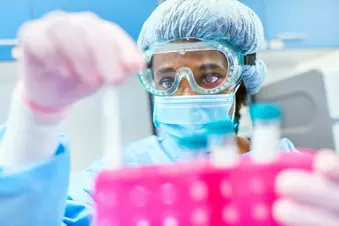
Doctors once thought non-small-cell lung cancer (NSCLC) was one disease. Most people got the same treatment -- chemotherapy (chemo) -- especially if their cancer had spread to other parts of the body.
Now, doctors know there are many different types of NSCLC, with “more coming down the pike,” says Nathan Pennell, MD, a medical oncologist specializing in thoracic cancer at the Cleveland Clinic’s Taussig Cancer Institute.
That means treatment plans are no longer once-size-fits-all. Instead, treatments like targeted therapies and immunotherapy are tailored to each person’s tumor.
Targeted Therapies
Some cancer cells have gene changes (also called mutations) that help them grow and spread. The goal of several targeted therapies is to block those changes. The FDA has approved medicines to treat eleven different gene mutations that can drive NSCLC:
- EGFR
- ALK
- BRAF
- ROS1
- RET
- MET
- KRAS
- PIK3CA
- HER2
- NTRK
- MEK1
One drug targets the growth of tumors on blood vessels:
- Ramucirumab (Cyramza)
Epidermal growth factor receptor -- or EGFR -- is the most common. It’s a protein on the surface of cells that helps them grow and divide. If you have too much EGFR, your cells grow faster than normal. Medicines called EGFR inhibitors stop this growth.
Karen Reckamp, MD, co-directs the lung cancer and thoracic oncology program at City of Hope in Duarte, CA. She says targeted therapy has completely changed the way doctors manage lung cancer. Now, before you start treatment for advanced NSCLC, you’re likely to have genetic testing to see if you have a mutation that might help guide your treatment.
Reckamp says this new way of doing things has changed the game for many people with advanced NSCLC.
“We don’t talk about a cure,” Reckamp says. “But the tumor shrinks, people feel better, go back to work, and have a better quality of life.”
Targeted therapies also have drawbacks. Some only work for the small number of people who have gene mutations that respond to a certain targeted therapy. About 15% of people with lung cancer have EGFR-positive lung cancer. The numbers are much smaller for other gene changes.
The medicines also have side effects, like:
- Skin rash
- Diarrhea
- Liver damage
- Bone marrow problems
Reckamp says these usually aren’t as severe as side effects from chemotherapy.
“For most people, the side effects are pretty tolerable, and they do pretty well.”
Another problem is that targeted medicines often stop working, eventually.
“Cancer cells find ways to survive and overcome the toxic treatments we’re giving them,” Reckamp says. “When that happens, you have to try a different treatment.”
Still, she says targeted therapies have greatly improved the odds for people with NSCLC.
“With chemotherapy alone, [extending life] by 1 year was as good as we could get. Now, with these therapies in addition to chemo, it’s not uncommon for patients to live 2, or even 5 years.”
Immunotherapy
Your immune system normally destroys cancer cells. But tumor cells are sneaky and can find ways to evade your body’s best defenses. If you have NSCLC, some cancer cells may churn out a protein called PD-L1. It attaches to another protein, PD-1, on important immune T cells. This is called an immune checkpoint, and it tells your T cells to leave the tumor alone.
One way to get around this is with medicines called checkpoint inhibitors. They prevent PD-L1 and PD-1 from getting together. This unleashes your immune system, so it’ll be at full power against cancer cells. But healthy cells get caught in the crossfire.
“Immunotherapy can cause inflammation anywhere in your body from head to toe,” Reckamp says. “When your immune system never turns off, you can get something resembling an autoimmune disease like rheumatoid arthritis. Or you can have problems with your thyroid, liver, bladder, kidneys, and heart.
“And this can happen anytime -- even after you’ve stopped treatment. But most symptoms can be well-controlled with high-dose steroids.”
Your doctor won’t suggest immunotherapy unless your tumor tests positive for high levels of PD-L1. The test isn’t always correct, though, and some tumors that test positive for PD-L1 may not respond to immunotherapy.
Still, Reckamp says immunotherapy is a better choice than chemo for most people who have it, despite the severe side effects and hefty price tag. It may even keep working after you stop taking it.
In the Pipeline
Reckamp says to look for improvements in targeted medicines and smarter drugs that can outwit and outlast cancer cells.
“There are lots of clinical trials focused on overcoming resistance to targeted medicines and immunotherapy, and combining these with chemotherapy to improve not just the length of a [person’s] life, but also the quality,” she says.
Show Sources
Photo Credit: Robert Kneschke / EyeEm / Getty Images
SOURCES:
Karen Reckamp, MD, co-director, lung cancer and thoracic oncology program, City of Hope, Duarte, CA.
Nathan Pennell, MD, medical oncologist, Cleveland Clinic’s Taussig Cancer Institute.
American Cancer Society: “Targeted Therapy Drugs for Non-Small Cell Lung Cancer.”
Johns Hopkins Medicine: “What are Immune Checkpoints, and How Can We Block Them?”
Dana-Farber Cancer Center: “What Is a PD-L1 Test?”
Andrews, A. Treating with Checkpoint Inhibitors -- Figure $1 Million Per Patient, American Health & Drug Benefits, 2015.